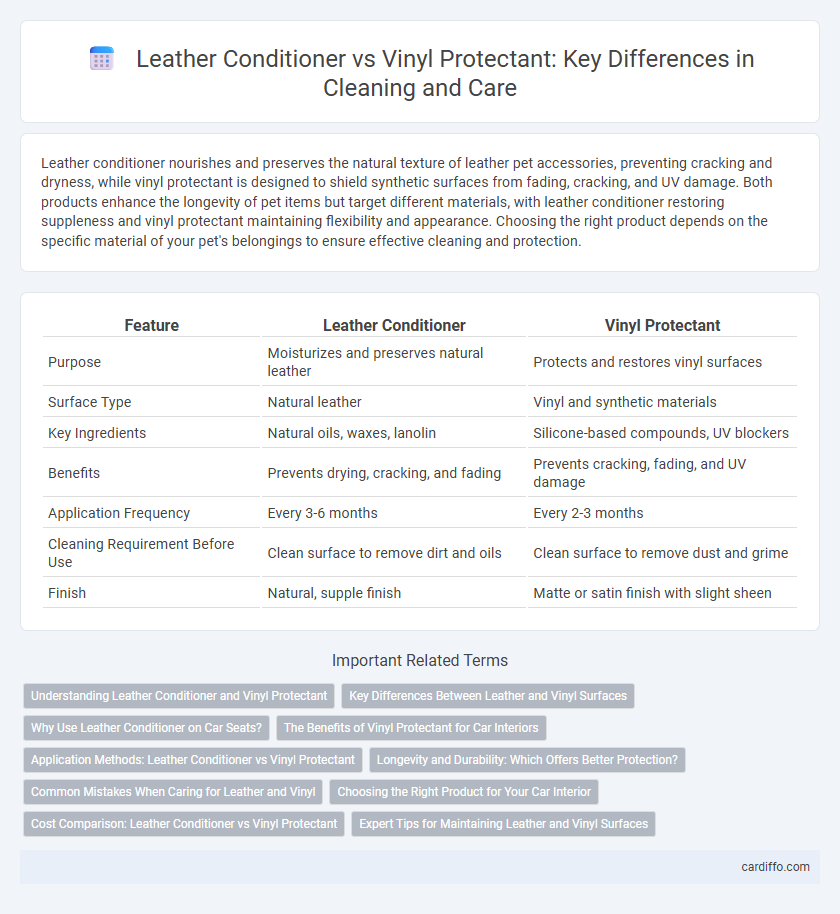Leather conditioner nourishes and preserves the natural texture of leather pet accessories, preventing cracking and dryness, while vinyl protectant is designed to shield synthetic surfaces from fading, cracking, and UV damage. Both products enhance the longevity of pet items but target different materials, with leather conditioner restoring suppleness and vinyl protectant maintaining flexibility and appearance. Choosing the right product depends on the specific material of your pet's belongings to ensure effective cleaning and protection.
Table of Comparison
| Feature | Leather Conditioner | Vinyl Protectant |
|---|---|---|
| Purpose | Moisturizes and preserves natural leather | Protects and restores vinyl surfaces |
| Surface Type | Natural leather | Vinyl and synthetic materials |
| Key Ingredients | Natural oils, waxes, lanolin | Silicone-based compounds, UV blockers |
| Benefits | Prevents drying, cracking, and fading | Prevents cracking, fading, and UV damage |
| Application Frequency | Every 3-6 months | Every 2-3 months |
| Cleaning Requirement Before Use | Clean surface to remove dirt and oils | Clean surface to remove dust and grime |
| Finish | Natural, supple finish | Matte or satin finish with slight sheen |
Understanding Leather Conditioner and Vinyl Protectant
Leather conditioner nourishes natural leather by replenishing oils and restoring flexibility, preventing cracks and drying. Vinyl protectant enhances synthetic vinyl surfaces by forming a protective barrier against UV rays, dirt, and fading without penetrating the material. Both products maintain surface durability but target different materials requiring specific formulations for optimal care.
Key Differences Between Leather and Vinyl Surfaces
Leather surfaces are porous and contain natural oils, requiring conditioners that replenish moisture to prevent cracking and maintain suppleness. Vinyl surfaces are non-porous, made from synthetic materials, needing protectants that create a protective barrier against UV rays and prevent fading or cracking. Leather conditioners absorb into the material, while vinyl protectants primarily sit on the surface to shield against environmental damage.
Why Use Leather Conditioner on Car Seats?
Leather conditioner maintains the natural oils in car seats, preventing cracks and dryness while enhancing durability and softness. It penetrates the leather surface to restore flexibility and preserve the material's integrity, ensuring a luxurious feel and appearance. Unlike vinyl protectants that form a surface barrier, leather conditioners nourish the leather deeply for long-lasting protection against wear and tear.
The Benefits of Vinyl Protectant for Car Interiors
Vinyl protectant enhances car interiors by providing superior UV resistance, preventing fading and cracking commonly found in dashboard and door panel materials. Its formulation repels dust and dirt, making surfaces easier to clean and maintain a like-new appearance longer. Unlike leather conditioner, vinyl protectant specifically targets synthetic surfaces, extending the life and aesthetic appeal of vinyl components in vehicles.
Application Methods: Leather Conditioner vs Vinyl Protectant
Leather conditioner is applied by gently massaging a small amount into the leather surface using a soft cloth or sponge, allowing it to absorb and restore natural oils without saturating the material. Vinyl protectant requires spraying or wiping onto the surface with a microfiber cloth to form a protective barrier that prevents cracking and fading caused by UV exposure. Both products need to be evenly applied in thin layers, avoiding over-application that can lead to residue build-up or surface damage.
Longevity and Durability: Which Offers Better Protection?
Leather conditioners penetrate deeply to nourish and soften leather fibers, enhancing longevity by preventing cracks and dryness. Vinyl protectants form a resilient surface layer that guards against UV rays, fading, and surface abrasions, significantly boosting vinyl durability. For long-lasting protection, leather conditioners excel in maintaining the natural flexibility of leather, while vinyl protectants provide superior defense against environmental damage on synthetic surfaces.
Common Mistakes When Caring for Leather and Vinyl
Using leather conditioner on vinyl surfaces can cause discoloration and deterioration, while vinyl protectants applied to leather often fail to nourish and preserve the material properly. Overusing products or neglecting to test them on a small area can lead to sticky residues and premature damage. Proper care requires selecting specific conditioners and protectants formulated for each material's unique properties to maintain durability and appearance.
Choosing the Right Product for Your Car Interior
Choosing the right product for your car interior depends on the material's unique needs; leather conditioners nourish and restore natural oils to prevent cracking and fading, while vinyl protectants create a barrier against UV damage and maintain flexibility. Understanding the differences ensures effective care: leather requires hydration to stay supple, whereas vinyl benefits from protective coatings to resist wear and sun exposure. Applying the appropriate treatment enhances durability and preserves the aesthetic of your car's interior surfaces.
Cost Comparison: Leather Conditioner vs Vinyl Protectant
Leather conditioner typically costs between $10 and $25 for an 8-ounce bottle, offering long-lasting protection and nourishment to natural leather surfaces. Vinyl protectants are usually slightly cheaper, ranging from $8 to $20 for a similar size, designed to restore and preserve synthetic vinyl materials effectively. Choosing between the two depends on the material type and budget, with leather conditioners generally priced higher due to the complexity of their formulation.
Expert Tips for Maintaining Leather and Vinyl Surfaces
Leather conditioner restores natural oils and prevents cracking, keeping leather surfaces supple and durable. Vinyl protectant forms a protective barrier against UV rays and dirt, reducing fading and cracking on vinyl surfaces. Regular application of the appropriate product according to the material ensures longevity and maintains appearance.
leather conditioner vs vinyl protectant Infographic

 cardiffo.com
cardiffo.com